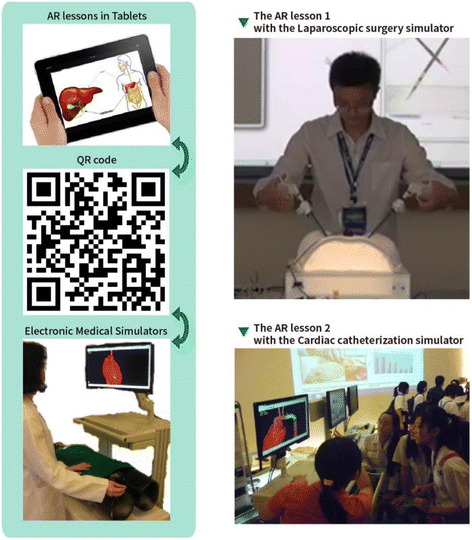
Augmented Reality in Anatomy 12
Theoretical Framework
When used appropriately, “AR can be used to bridge the gap between practical and theoretical learning practices along with real and virtual components being blended together to create a unique learning experience” (Antonioli, 2014, p 97). When viewed through an educational lens, Augmented Reality (AR) can draw from a number of learning theories:
-
Constructivism
“AR educational programs are student-centered and related to student interests. It allows students to explore the world in an interactive way. Constructivism also encourages students to work collaboratively, and AR provides students the opportunity to do this in a traditional school setting as well as in distance education.” (Antonioli, 2014, p 97)
-
Just-In-Time Learning Theory
Students will learn information at the moment when they need to know it. (Antonioli, 2014, p 97)
-
Situated Learning Theory
The essence of situated learning is “to "anchor" or "situate" instruction in the context of meaningful problem-solving environments that allow teachers to simulate in the classroom some of the advantages of "in-context" situations” (Cognition and Technology Group at Vanderbilt, 1992b, p 294).
-
Self-Determination Theory (SDT)
“SDT defines learning that occurs through motivation…..students are engaged because they are in charge of their own learning.” (Antonioli, 2014, p 97)
-
Flow Theory
“Flow theory describes how people who are engaged in meaningful activities are more likely to stay focused.” ( Bressler, & Bodzin, 2013, p 506)
-
Games-Based Learning
Augmented reality systems can be used to facilitate immersive games-based learning by creating a digital narrative, placing students in a role, providing authentic resources and embedding contextually relevant information. (Dunleavey, Dede, & Mitchell, 2009)
-
Inquiry-Based Learning
“Students showed high frequencies on higher-level inquiry behaviors, such as interpreting experimental data or making conclusions more thoroughly when using AR simulations over traditional 2D simulations” (Wang, Duh, Lin, & Tsai, 2014, p 382).

AR in Health and Science
AR is a natural fit with the field of health and science. “If an educator is looking to model science practice, AR provides the opportunity to support the multifaceted world of science exploration” (Antonioli, 2014, p 99). AR being used for visual guidance in conjunction with probeware and sensors can help bring a more student centered dynamic to a learning experience. “A key pedagogical affordance of Augmented Reality is the ability to rescale virtual objects, from molecules to planetary bodies, allowing students to better understand through manipulation the properties and relationships of objects that would be either too small or too large to examine effectively in their normal day-to-day lives” (Bower, Howe, McCredie, Robinson, & Grover, 2014, p 5). In addition to rescaling, AR provides the opportunity to explore the internal components of the human body without the ethical or practical concerns associated with working on a patient or cadaver. Whole body systems can be explored in detail without ever opening a body. AR can provide context to theoretical biological frameworks that may be hard for students to visualise.

Designs of authentic inquiry activities with tablets and surgery simulators (Hsu et al., 2016, Fig. 4)
Additionally, AR lessons have been shown to help motivate students to choose STEM-related majors in university by linking electronics and medical science to save lives (Hsu, Lin, & Yang, 2016, p 11). They provide opportunities to combine STEM content with practical skills such as medical surgery. Surgery simulators that combine sensors, probes, and AR provide medical students with realistic hands-on opportunities to practice techniques as frequently as they choose. AR use in these settings has been shown to trigger high levels of motivation and engagement (Hsu, Lin, & Yang, 2016, p 1).
Using these techniques can help shift classrooms from traditional lecture styles to environments that are more lab and student-oriented (Antonioli, 2014, p 98). By incorporating real-world applications within a virtual experience, these student-centered activities can be further enhanced. AR design promotes investigation and problem-solving that complement the problem-based nature of science (Goff, Mulvey, Irvin, & Hartstone-Rose, 2018, p 435).
BC Curriculum
The province of British Columbia has a new curriculum that focuses on flexible and ICT-enabled learning environments, inquiry and question-based approaches, and collaboration with community. Based on the learning theories presented earlier, AR covers all of these aspects. The curriculum is now focused less on content and more on process and skill development. Critical thinking, questioning, exploration and real life applications are now major components of the new curriculum.

Anatomy and Physiology Grade 12 Relevant Curricular Competencies:
-
Demonstrate a sustained intellectual curiosity about a scientific topic or problem of personal, local, or global interest
-
Make observations aimed at identifying their own questions, including increasingly abstract ones, about the natural world
-
Collaboratively and individually plan, select, and use appropriate investigation methods, including field work and lab experiments, to collect reliable data (qualitative and quantitative)
-
Experience and interpret the local environment
-
Use knowledge of scientific concepts to draw conclusions that are consistent with evidence
-
Connect scientific explorations to careers in science
-
Communicate scientific ideas and information, and perhaps a suggested course of action, for a specific purpose and audience, constructing evidence-based arguments and using appropriate scientific language, conventions, and representations